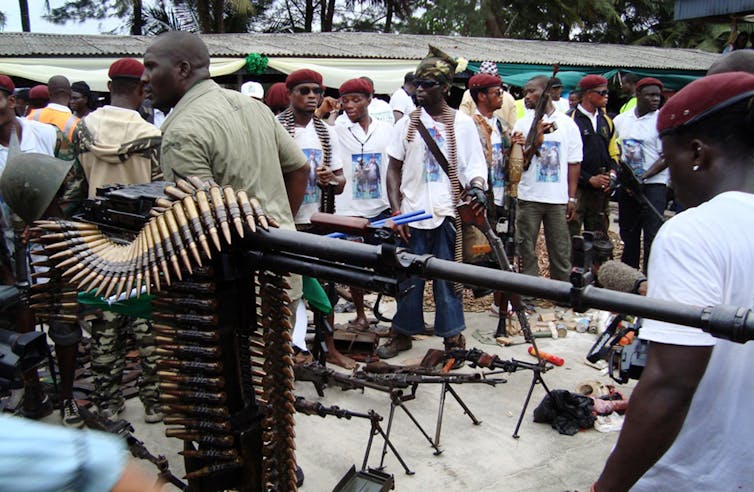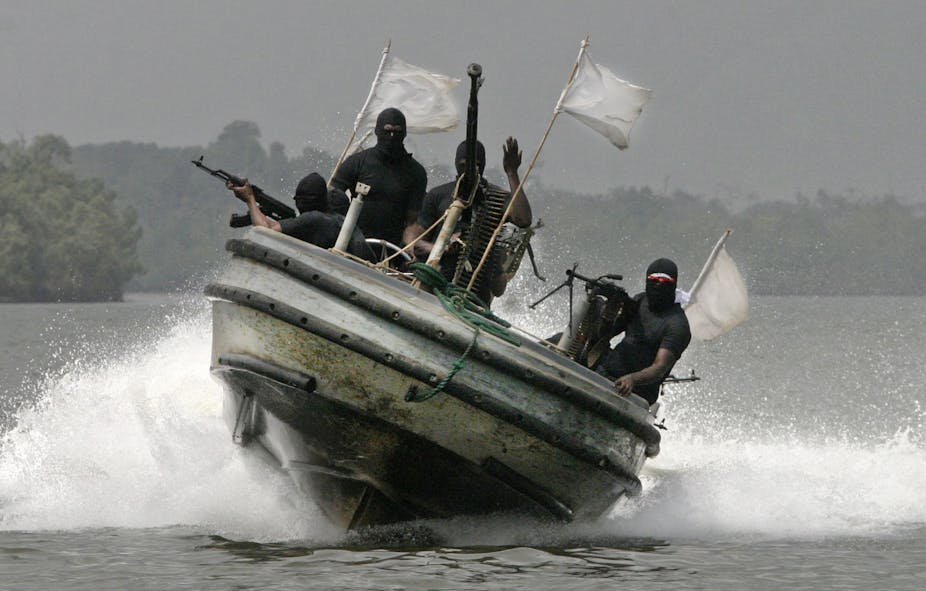The introduction of disarmament, demobilisation and reintegration programmes have become common practice in countries emerging from violent conflict. Arguably, the most difficult aspect is the successful and long-term reintegration of former combatants into civilian life.
In Nigeria this was certainly the case. The country’s disarmament, demobilisation and reintegration programme is known locally as the amnesty program. It was introduced by the late President Umaru Musa Yar’Adua in 2009 and was aimed at members of armed militant groups that were present in the Niger Delta. This includes; the Movement for the Emancipation of the Niger Delta, Niger Delta People’s Volunteer Force, and Niger Delta Vigilante.
These militant groups emerged around 2006 and were known for their violent attacks on the region’s oil infrastructure and kidnapping oil companies’ employees for ransom. As a result of the violence and instability, the production and export of oil from the Niger Delta region decreased sharply after 2006.
The amnesty programme was set up to put an end to this. Its main objective was to disarm, demobilise and reintegrate armed militants back into communities. The programme involved offering benefits – such as opportunities in education as well as money – to militants who gave up their weapons.
Our ongoing research project at the University of Leuven identified why the initiative failed and highlights why programmes of this nature can fall apart. A major finding was that it wasn’t accompanied by meaningful and durable reintegration and that deep-seated socio-economic problems weren’t tackled at the same time.
Terms of the amnesty
Under its terms militants who freely handed over their weapons and demobilised wouldn’t be prosecuted and would even receive benefits. These benefits included; a formal education in Nigeria or abroad, small loans to start businesses as well as a monthly allowance of about US$400. The allowance was significantly higher than Nigeria’s minimum wage of about US$60 per month.
Leaders of militant groups were also offered large and highly profitable contracts in the oil industry and other sectors of the economy. In the wake of the amnesty programme, ex-militant leaders gained political power and influence in the cities to which they returned.

The programme initially resulted in a sharp reduction of violent attacks against the oil industry, leading to an increase in production. But cracks in the deal started to emerge.
Due to a sharp fall in oil prices, the programme became increasingly difficult for the Nigerian government to fund. In May 2015, for instance, the allowance payments to the enrolled ex-militants had to be suspended. This made matters worse and reignited tensions as a large number of ex-militants are unemployed and highly dependent on the monthly allowances.
Failures
One major problem is that the Nigerian government failed to tackle wider socio-economic grievances. These include the lack of social development in local oil communities, environmental pollution and the exclusion of local communities from the governance of oil production in the Niger Delta region.
New militant groups emerged in the last 18 months. They claim to represent the grievances of local oil communities. These groups include the Niger Delta Avengers (NDA), Red Scorpions and the Niger Delta Greenland Justice Movement (NDGJM). They have again started to attack the region’s oil infrastructure, resulting in a reduction of Nigeria’s oil production from 2.2 million to about 1.1 million barrels per day in 2016.
Our research also showed that Nigeria’s financial incentives actually worked as a disincentive for sustainable reintegration.
Firstly, ex-militants preferred to remain enrolled in the amnesty programme, instead of switching to lower-paying jobs in their communities.
Secondly, they started attracting new youth into militancy. The amnesty programme was initially designed for youths who were active members of armed militant groups. Evidence shows that youths, who weren’t part of any armed militant group, started to mobilise into new groups or join existing ones in order to benefit from the amnesty programme. In some instances, they quickly purchased weapons from the black market to enable them to participate in the programme.
Recognising this, the Nigerian government in September 2011 stopped the inclusion of new militant groups into the amnesty programme. But discontent over who’s and who’s not allowed to enrol have remained. This is partly behind the emergence of the Niger Delta Greenland Justice Movement (NDGJM) in Delta State.
The renewed instability and violent attacks in the region have again resulted in a serious reduction of the country’s oil production. This has complicated the Nigerian government’s already formidable financial and economic concerns and challenges. And attempts by the Nigerian government to use force against the (new) militant groups have proved unsuccessful as the militants continue to evade direct confrontation with the military.
What now?
It appears, despite all its failures, that the only short-term option to get the county’s oil production and exports back on track quickly is the continuation and possible expansion of the current amnesty programme to address the new groups that have emerged.
This would help increase oil exports and revenues and buy the government time to develop more effective reintegration strategies. However, any new amnesty strategy will need to de-emphasise financial payments to ex-militants for it to succeed. Instead, it will need to focus on underlying issues such as the development deficits and environmental pollution affecting communities. In the long term, the government should design transparent mechanisms which include local communities in the governance of oil production. This will reduce the tensions that provide justification for militancy in the region.

